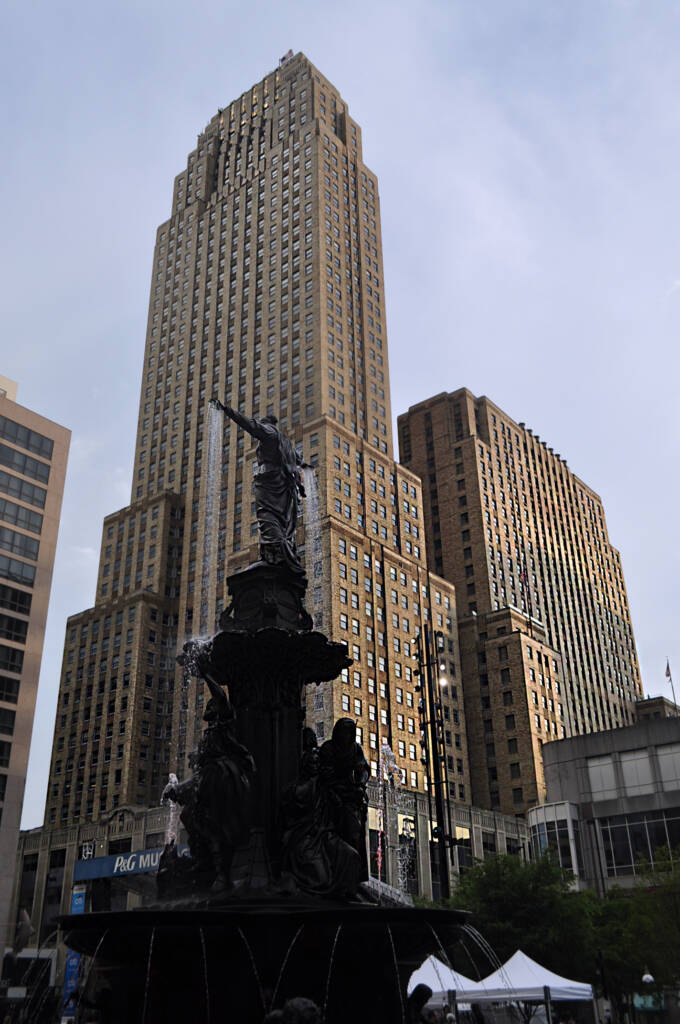Welcome to the heart of Cincinnati, where history meets architectural splendor in the form of the iconic Carew Tower. As you step into the vibrant downtown area, this towering masterpiece beckons with its timeless allure, offering a journey through the city’s rich past and a glimpse into its dynamic present.
Constructed in 1930 amidst the Art Deco movement, the Carew Tower stands as a living testament to the resilience and innovation of its era. Designed by the esteemed architectural firm Shreve, Lamb & Harmon, the same visionaries behind the Empire State Building, the tower boasts a unique blend of Gothic and French Art Deco influences. Its limestone façade and intricate details are a testament to the opulence of the Roaring Twenties, even as the Great Depression posed challenges to its completion.
Beyond its architectural marvels, the Carew Tower serves as a timeless vantage point for those seeking a panoramic perspective of Cincinnati. Ascend the 49-story structure to its observation deck and be treated to breathtaking views of the cityscape, the meandering Ohio River, and the rolling hills beyond. It’s not just a building; it’s a living testament to Cincinnati’s evolving skyline and an integral part of the city’s cultural identity.
Adaptation and resilience are woven into the Carew Tower’s narrative. Originally conceived as part of a hotel complex, the tower has weathered economic shifts and urban development. Today, it stands as a symbol of Cincinnati’s ability to embrace change while preserving its heritage. Join us on a journey through time and architecture as we explore the captivating story of the Carew Tower, inviting you to witness the city’s charm from new heights.
Table of Contents
Historical Background
At the intersection of Cincinnati’s storied past and architectural grandeur stands the Carew Tower, a timeless landmark that echoes the triumphs and challenges of a bygone era. Conceived during the pinnacle of the Roaring Twenties and completed in 1930, the tower emerged as a testament to the enduring spirit of Cincinnati despite the economic tempest of the Great Depression.
Designed by the esteemed architectural firm Shreve, Lamb & Harmon, the same visionaries behind the iconic Empire State Building, the Carew Tower was originally envisioned as the centerpiece of a comprehensive hotel complex. Its construction, however, faced the economic tumult of the early 20th century, underscoring the challenges posed by the Great Depression. Despite these adversities, the tower’s completion marked a triumph of determination, showcasing the city’s commitment to architectural excellence and its unwavering resilience.
As a product of the Art Deco movement, the Carew Tower’s design reflects the opulence and sophistication of its time. The use of limestone in its construction, along with intricate Art Deco details, contributes to the tower’s striking visual appeal. In exploring the historical background of the Carew Tower, one not only unravels the threads of its construction but also gains insight into the broader cultural and economic landscape that shaped this architectural masterpiece. It stands today as more than a structure; it is a living artifact that transports visitors to a bygone era, offering a glimpse into the spirit and aspirations of Cincinnati in the early 20th century.
Architectural Marvels
The Carew Tower stands as a testament to architectural ingenuity, a striking embodiment of the Art Deco movement that has graced Cincinnati’s skyline since its completion in 1930. Designed by the renowned architectural firm Shreve, Lamb & Harmon, the same visionary minds behind the iconic Empire State Building, the tower’s architectural marvels are a captivating blend of Gothic and French Art Deco influences.
The façade of the Carew Tower is a study in meticulous craftsmanship, with its limestone exterior exuding a timeless elegance. The architects’ attention to detail is evident in the intricate Art Deco embellishments that adorn the 49-story structure, creating a visual tapestry that captivates the eye. As sunlight dances on the limestone surface, the tower becomes a living canvas, showcasing the opulence and sophistication of the Roaring Twenties.
What sets the Carew Tower apart is not just its exterior, but the innovative design elements that define its interior spaces. The use of setbacks in the tower’s structure not only adds to its visual appeal but also serves a functional purpose, allowing for efficient use of space while contributing to the building’s iconic silhouette. Each floor unfolds with a sense of purpose, revealing a seamless fusion of aesthetic beauty and practical design principles.
As visitors explore the Carew Tower, they are treated to a journey through architectural history. From the lobby’s intricate detailing to the sweeping views from the observation deck, every facet of the tower reflects the commitment to excellence that defined the Art Deco era. The Carew Tower stands not only as a symbol of Cincinnati’s architectural prowess but also as a living masterpiece that invites admiration for the fusion of art and engineering that defines its very essence.
Observation Deck and Views
Perched atop the Carew Tower, the observation deck offers an unrivaled panoramic spectacle, inviting visitors to witness Cincinnati’s ever-changing skyline in breathtaking detail. Ascending the 49-story architectural marvel, guests are transported to a vantage point that transcends time, providing a captivating journey through the city’s past, present, and future.
From this elevated perch, the Cincinnati skyline unfolds in all its splendor, a testament to the city’s growth and evolution. The meandering Ohio River, a vital artery of commerce and history, weaves its way through the landscape, reflecting the city’s deep connection to waterborne trade and transport. The rolling hills beyond the urban expanse add a picturesque touch, reminding onlookers of Cincinnati’s unique topography.
The observation deck itself is not merely a platform; it’s a curated experience. Floor-to-ceiling windows wrap around the space, framing the cityscape like a living canvas. As natural light bathes the interior, the architectural details of Cincinnati’s iconic structures come to life, each one telling a story of the city’s journey through time. From the historic neighborhoods to the modern skyscrapers, the views from the Carew Tower offer a captivating narrative of urban development and resilience.
Day or night, the observation deck provides an ever-changing spectacle. As the sun sets, the city lights flicker to life, casting a warm glow over the Queen City. The illuminated bridges, bustling streets, and distant hills create a mesmerizing panorama that captures the essence of Cincinnati after dark.
The Carew Tower’s observation deck is more than a lookout point; it’s a window to Cincinnati’s soul. Whether you’re a local seeking a new perspective or a visitor eager to absorb the city’s charm, the views from this elevated haven promise an unforgettable experience that lingers in the memory, inviting all to become a part of Cincinnati’s unfolding story.
Evolution and Adaptive Reuse
The Carew Tower’s journey through time reflects not only architectural resilience but a compelling story of evolution and adaptive reuse, cementing its status as a dynamic cornerstone in Cincinnati’s urban narrative. Originally conceived as part of a comprehensive hotel complex in the early 1930s, the tower’s construction weathered the economic challenges of the Great Depression, emerging as a symbol of the city’s unwavering spirit.
As decades unfolded, Cincinnati underwent urban transformations, and the Carew Tower adapted to the changing needs of its community. The tower transitioned from its initial role as a hotel to a mixed-use space, showcasing an impressive capacity for flexibility and innovation. Today, it stands not just as a historic relic but as a vibrant hub that continues to contribute to the city’s cultural and economic fabric.
The adaptive reuse of the Carew Tower has breathed new life into its spaces. What once housed hotel guests now accommodates modern offices, restaurants, and retail spaces. This evolution preserves the tower’s architectural grandeur while ensuring its relevance in a contemporary context. The blending of historical charm with modern functionality pays homage to Cincinnati’s rich past while embracing the dynamism of its present.
Beyond its physical transformation, the Carew Tower remains a testament to Cincinnati’s ability to adapt to the ebb and flow of economic tides. Its adaptive reuse stands as a model for sustainable urban development, demonstrating how a city’s landmarks can remain integral to its identity while serving the evolving needs of its inhabitants.
In essence, the Carew Tower’s evolution and adaptive reuse embody the spirit of Cincinnati itself—a city that values its history but isn’t bound by it. As visitors explore its halls or gaze from its observation deck, they become witnesses to a living legacy, a testament to the city’s resilience, innovation, and the enduring beauty of architectural adaptation.
Nearby Attractions
Nestled in the heart of Cincinnati, the Carew Tower not only stands as a captivating architectural gem but also serves as a gateway to an array of nearby attractions that enrich the city’s cultural tapestry. As you explore the surroundings of this iconic tower, you’ll find a diverse array of experiences awaiting you, ranging from historical landmarks to vibrant entertainment districts, ensuring that your visit to the Carew Tower is complemented by the charm and diversity of its neighboring attractions.
Nearby Attractions:
- Fountain Square: Just a short stroll from the Carew Tower, Fountain Square is a bustling hub of activity featuring an iconic fountain, live events, and an array of dining and shopping options, making it a vibrant gathering place for locals and visitors alike.
- Cincinnati Art Museum: Immerse yourself in the world of art at the Cincinnati Art Museum, located a short drive away. Housing an extensive collection spanning various eras and cultures, the museum offers a rich cultural experience.
- Great American Ball Park: Baseball enthusiasts can catch a game at the nearby Great American Ball Park, home to the Cincinnati Reds. Experience the thrill of America’s favorite pastime in a stadium known for its picturesque views of the Ohio River.
- Cincinnati Music Hall: For a dose of architectural and musical splendor, venture to the Cincinnati Music Hall, a historic venue renowned for its stunning architecture and as the home of the Cincinnati Symphony Orchestra.
- Over-the-Rhine District: Imbued with historic charm, the Over-the-Rhine district is a trendy neighborhood boasting a mix of eclectic boutiques, art galleries, and a vibrant culinary scene. Stroll along its cobblestone streets and absorb the atmosphere of this revitalized historic district.
- National Underground Railroad Freedom Center: Delve into the poignant history of the Underground Railroad at the Freedom Center, located along the banks of the Ohio River. This museum offers immersive exhibits and insights into the struggle for freedom and equality.
- Cincinnati Zoo & Botanical Garden: A family-friendly option, the Cincinnati Zoo is home to a diverse array of wildlife and beautifully landscaped gardens. Experience the wonder of the animal kingdom in this renowned zoological park, located a short distance from the Carew Tower.
- Taft Museum of Art: Immerse yourself in art history at the Taft Museum, housed in a historic mansion. The museum showcases an impressive collection of European and American masterpieces.
- Cincinnati Shakespeare Company: Catch a performance at the Cincinnati Shakespeare Company, dedicated to bringing classic and contemporary plays to life in a beautifully restored historic venue.
Conclusion
In conclusion, the Carew Tower stands not only as a towering testament to Cincinnati’s architectural prowess but as a living chronicle of the city’s rich history, adaptability, and vibrant spirit. From its origins in the opulent era of the 1930s to its modern-day role as a mixed-use marvel, the tower reflects the resilience of Cincinnati itself—a city that has weathered challenges while embracing change with grace and innovation.
As visitors ascend to the observation deck, they not only witness the panoramic views of Cincinnati’s evolving skyline but also become part of a narrative that spans generations. The architectural marvels, historical significance, and adaptive reuse of the Carew Tower encapsulate the essence of Cincinnati, inviting all to appreciate the beauty of a city that honors its past while boldly stepping into the future. Whether exploring the nearby attractions that complement its presence or simply marveling at its grandeur, the Carew Tower serves as an enduring symbol—a beacon that beckons all to immerse themselves in the rich tapestry of Cincinnati’s past, present, and future.






